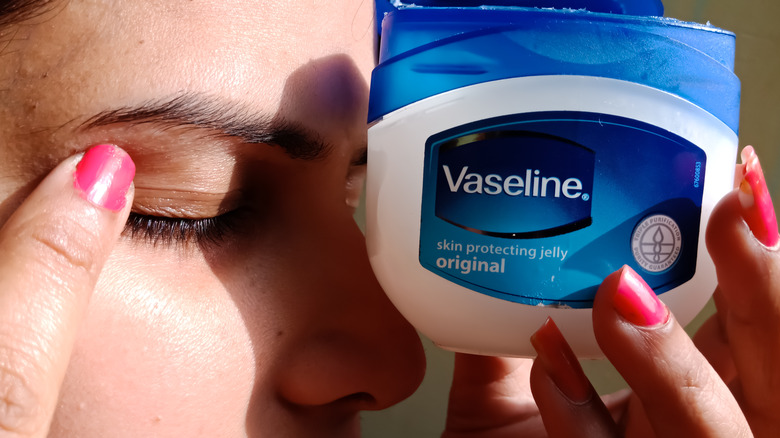Vaseline Should Take Up Space In Your Beauty Routine (Yes, Mom Was Right)
There are few products on the beauty market that have stood the test of time, like Vaseline. Founded and created in Brooklyn, New York, in 1870, the brand has managed to earn itself a place in generations of skincare regimens for its ability to soothe dry or cracked skin, soften cuticles, protect the skin barrier, and among other uses, even removing clothing stains. To keep it brief: if your mom told you Vaseline was a must-have product, she might have been right. Plus, it doesn't cost much, with vats of the original formula and off-brand formulations of petroleum jelly costing just a fraction of the concoctions you might find at Sephora.
So, how should you use Vaseline? Is it right for your skin? These are all valid questions, especially if you've seen the "slugging" tutorials on TikTok. For the uninitiated, "slugging" refers to a multi-step regimen that includes layering your face in products — toners, serums, creams — and then adding Vaseline or a similar product as a last step before going to sleep. The term "slugging" refers to the shiny, glazed appearance of the skin immediately after application. Below, we run down the many varied uses of Vaseline, and whether it might be right for your skin type.
Vaseline as part of a multi-step regimen
Before we get too far, it's important to note that Vaseline is actually an occlusive product, meaning it doesn't add moisture to your skin — but it does help retain the moisture that's already there and prevents water loss during sleep. Its occlusive properties are the main reason it's incorporated as the last step in "slugging." After applying hydrators and moisturizers, you can "lock in" that nourishment by slathering on some ole' petroleum jelly. If that sounds like too much for you, splashing your face with some water will do the trick as well. According to the American Academy of Dermatology Association, wetting the face and then applying a thin layer of Vaseline on the eyelids, lips, or other areas prone to dryness can help retain moisture and protect the skin.
Some dermatologists also recommend using it in combination with active ingredients. "I often use hyaluronic acid, glycerin, or other hydrators underneath to maximize the benefit," California dermatologist Amelia K. Hausauer, MD, tells New Beauty. "However, I don't recommend this for all skin types. It is best for those with dry skin, sensitive skin, or a compromised skin barrier like after a laser or other procedure. And even if it works for you, you may only need to do this a few times a week, not daily."
Is it for everyone?
The short answer here is probably not. If you're using an ingredient known for drying out the skin (looking at you, Retin-A), Vaseline paired with a hydrator can help repair the skin barrier. However, if you're using Retin-A to reduce acne, be somewhat cautious of Vaseline. While some users swear Vaseline has helped reduce cystic acne, the American Academy of Dermatology reports that it has worsened breakouts for some people. That said, it doesn't clog pores on its own; the molecules are too big to fit into pores, and the product is non-comedogenic. Some studies have even shown that it's safe to use on acne-prone skin. Dermatologists recommend patch-testing and slowly working it into your skincare routine to see what your individual results will be.
Whether Vaseline is right for you may also depend on how you feel about having heavy textures line your face. As you might have gathered from the term "slugging," it's a heavy formulation. It also lasts a long time, meaning if you're "slugging" every other night, you probably should be prepared to wash your pillowcases frequently.
All that aside, Vaseline (or any similar petroleum jelly product) should probably be included somewhere in your bathroom cabinet. Even if you're not using it on your face, its sealing properties have been known to accelerate wound healing and some people even use a tiny amount on the back of the ears and wrists as a primer for perfume. The more you know!
